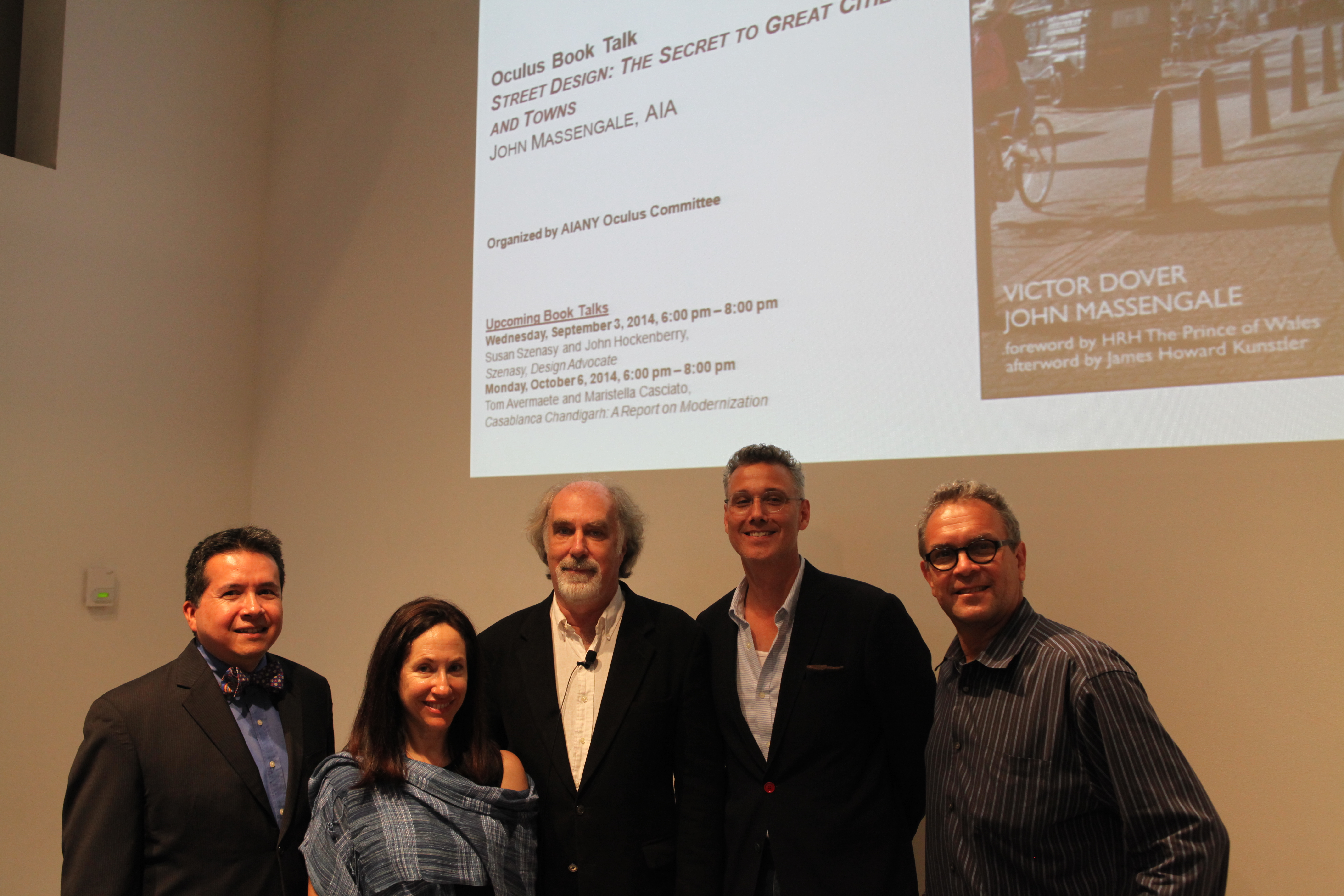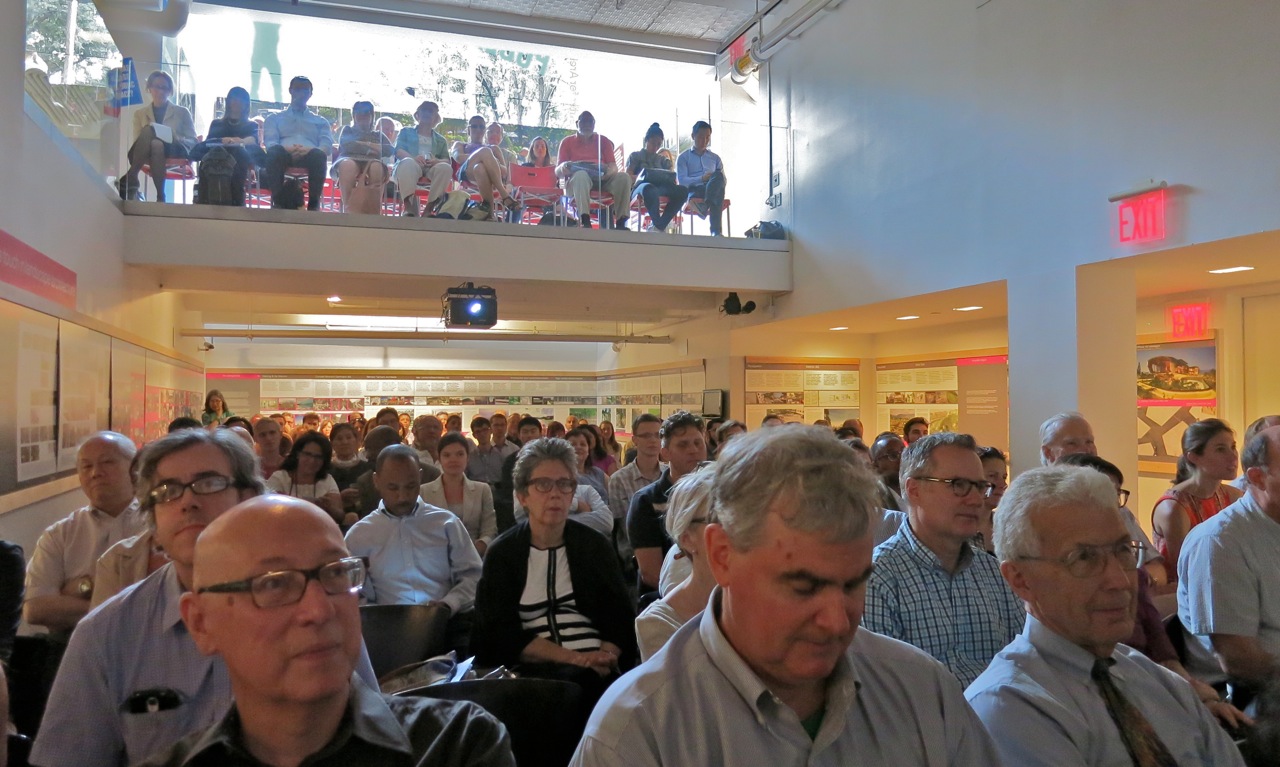by: ac
Street Design: The Secret to Great Cities and Towns is a fine text for professionals and student of urban design. This book can live on one’s desk and be a constant reminder of the New Urbanist standards that can craft urban environments. The textbook-like graphic interruptions and the uneven quality of images makes it feel more guidebook than linear narrative, but it is a thorough compendium of urbanist information. Authors Victor Dover and John Massengale, AIA, specify a series of typologies in the first chapter, “Historic Streets,” which is a tremendous argument in itself for how to read various cities. Massengale has an affable tone and gentle manner. This is exhibited in his prose as well as at his presentation for the AIANY Oculus Book Talk given at the Center for Architecture on 08.11.14. Time spent with the book and Massengale himself renders decades of street observation and interrogation. We all yearn for his vision of a Good Street.
The authors’ choice of exemplary streets is reduced to very established and refined conditions. New York City’s East 70th Street was meticulously discussed in Massengale’s talk as well as in the book to illustrate the power of the street tree and the attention to street width to building height ratio. His very long and insightful chapter on Nantucket garnered some interesting insights as to how an almost ancient street developed and how this history charts human behavior. But these are very expensive neighborhoods, and the desire to manage and maintain control over these public spaces is strong. He did speak about Brooklyn’s Eastern Parkway and Ocean Boulevard, which are spaces inhabited by working-class people. These two Frederick Law Olmsted works are constantly evolving to accommodate very different demographics and car usage, all the while maintaining Massengale’s good street criteria: mature tree canopies and healthy interaction between cars and people. Massengale provides us with very clear diagrams of street sections that describe the number of cars that flow through the roadway, and the places that people occupy on either side and in-between the roadway. These street sections also show that slight elevation changes in the cross section make for an inviting hierarchy and choreography in street life. He cites Monument Avenue in Richmond, Virginia, and its elevated porches, which instills a sense of dignity to the pedestrian.
One of the most captivating narratives, and when authors’ storytelling is at its best, is the story of the New Urbanist community of Seaside. Massengale relays that developer Robert Davis set up a stand to sell sangria and building lots. He also used lots as payment for architects who worked on the initial design proposals. These instances point to Davis as an innovative entrepreneur and an urbanist who developed a value system as well as a viable business proposition. These small gems of narrative are the exciting things in the text. Massengale’s vast history with urbanism is more interesting than the actual street conditions that he illustrates.
In his talk, I was captivated by Massengale’s use of films of New York City from the turn of the century. The footage showed pedestrians walking deep into the street and hopping onto a street car, illustrating pedestrians’ comfort with vehicles; a car co-existence almost. Massengale explained that the need to move through the streets at a faster pace has destroyed this easiness within street life. If car speeds were to be reduced, maybe the street as public space would become more viable. This is a radical and interesting proposition; rather than banish the vehicle, let’s re-introduce its function in a safer manner.
In all Massengale’s descriptions there is an account of why the road or street acquired the configuration; but in the moving forward and assessing of the dreaded “auto-sewer,” he doesn’t make that leap towards a solution, except for reintroducing the center-walkway boulevards of the past. It seems that this should be the next step in his work, overlaying some “good street” tenants to an average auto-sewer. I fear that the world has moved a bit faster than these “good streets” have, but the text is a gentle catalog of the good and the great in the history of urbanist thought.
Event: Oculus Book Talk: John Massengale, Street Design
Location: Center for Architecture, 08.11.14
Speaker: John Massengale, AIA
Organized by: AIANY Oculus Committee
Co-sponsored by: CNU New York
Oculus Book Seller: McNally Jackson Books










